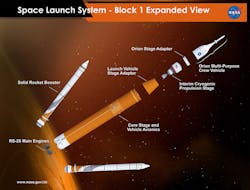Cryogenic Seal Plays Key Role in Deep-Space Ventures
In its Space Launch System (SLS) Project, NASA aims to increase human and robotic exploration of deep space. Several missions will bring the Orion Spacecraft to the depths of the solar system, exploring planets, asteroids, and other bodies that lie beyond low Earth orbit (LEO).
A seal developed by Saint-Gobain Seals. with a diameter measuring larger than six feet, will be used in the SLS space crafts. The OmniSeal RACO spring-energized seal can withstand a vacuum and pressures higher than 3000 psi. Their ruggedized construction can handle cryogenic space conditions and high-temperature applications, making them useful for future missions to hot planets and the sun.
The OmniSeal seal will be used in the first SLS mission, Exploration Mission 1 (EM-1), which is an un-crewed validation mission that is expected to launch in late 2018. The purpose of EM-1 is to demonstrate the performance of the SLS rocket and Orion spacecraft. The second mission, EM-2, will take four astronauts past the moon for the first time since the Apollo 17 mission in 1972.
Saint-Gobain seals and polymers have also been used in other NASA projects, including the Space Shuttle Program, International Space Station, Falcon 9 rocket, Atlas V launch vehicles, Delta IV Heavy rocket, and Mars rover Curiosity. Future SLS missions that bring robots and satellites to intense locations, including Jupiter, Mars, and the Sun, expect to employ the seal as well.

